Miles ridden (according to odometer): 3528.3
Miles ridden (based on summing up these routes): 3338
Longest Day: day 5, 8am-midnight
I did not include incidental mileage around Wisconsin, where I stayed over for 5 days visiting family. 200 miles of riding over those five days seems about right to me, although I wasn’t keeping track.
Just for fun and relaxation, I made google maps of the routes that I took to get to Waterford, WI. These maps represent the ride I actually took, including detours and navigational failures that involved turning around and sucking up 60 miles of error to get back to the main path.
Day One:
Berkeley, CA to Wendover, UT via the Golden Gate Bridge – 641 Miles
I decided to make the trip a little bit more interesting by hitting the Golden Gate Bridge on the way out, and stopping at the Brooklyn Bridge at the other side. It gave the ride a theme and made for a good story to tell to folks you meet on the road.
Your intrepid explorer rolling out, and then in front of the Golden Gate Bridge:
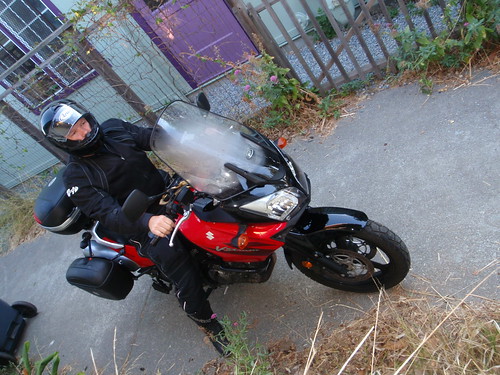
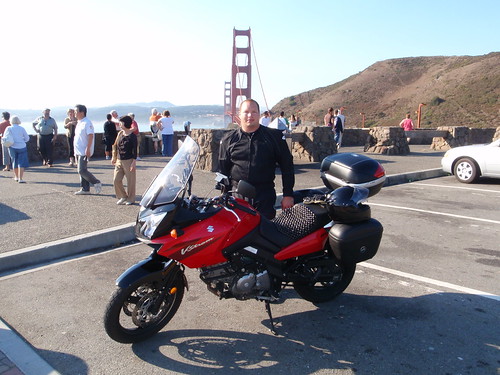
I should note that the picture of my in the driveway was posed before I put my riding gloves on (so that I could put the camera into my pocket more easily afterward).
The route to Nevada is very simple: Get on 80E and don’t get off. It’s a route I’m very familiar with as it tends to be the one that you take to Tahoe for skiing as well as a certain festival held in desert in Nevada every summer. It was a different experience going over Donner Pass with a vehicle that had a much more favorable power-to-weight ratio. Essentially, I’m the fastest and lightest thing on the road. As long a big rig isn’t trying to pass another big rig, I’m doing the speed limit the entire way. When I do get stuck behind something slow moving, I’m the first one past it and can easily put some distance between me and the guy behind, which contributes to the safety of a motorcyclist (me).
The views and landscapes coming over the mountains are pretty incredible. When I was growing up in the dessert (San Diego) where everything was dry all the time, I never understood how others considered it beautiful. I longed for the lush and tropical paradises of places that had seasons of note. As an adult, however, i’ve really come to appreciate it. Moving north to Berkeley may have helped a lot, since we get rain on a pretty regular basis here.
I decided that my lunch stop would be in familiar territory in Reno, NV. This is the parking lot outside the grocery store and water store, which if you’ve attended the aforementioned festival in the desert will look very familiar to you (this was 2+ weeks after). Also, note the super stylish helmet-induced faux-hawk:

The plan was to stop in Elko, NV, but I was feeling way too good to stop there. I was in good shape and had plenty of energy and daylight left for riding. I had not, however, chosen my route into South Dakota yet. The town after Elko, Walls, is the point where you would turn north if you wanted to take the route through Yellowstone, which I was seriously considering. Pulling out of Elko, however, I saw signs for the Peppermill in a town called Wendover. I have a soft spot in my heart for the fireside lounge at the Peppermill that used to be in Sunnyvale, and Wendover was the right distance for a stopping point, so I decided to continue east past Walls. This made the route choice for me.
Wendover is a gambling town in Nevada, and a depressing town in Utah. Eash Wendover is in Utah, and West Wendover is in Nevada. It’s your basic border gambling town. I had dinner inside the Peppermill casino, which was exactly like you’d expect it to be. No one looked like they were having a whole lot of fun inside. The patrons and the staff all looked to have a sort of bored malaise about them. I should note that there was no fireside lounge at this location, which was a bit disappointing. I can only imagine that, being in Nevada, there isn’t sufficient demand for that kind of slightly-less-than-wholesome fun because they’re competing with the other kinds of in-no-way-wholesome fun that Nevada has on offer. (The waitresses at the fireside lounge were costumed in top hats, tails, and fishnets, if I remember correctly: for what it’s worth, I think my interest in the fireside lounge is to the absurdity of it.)
Dinner in the Peppermill:
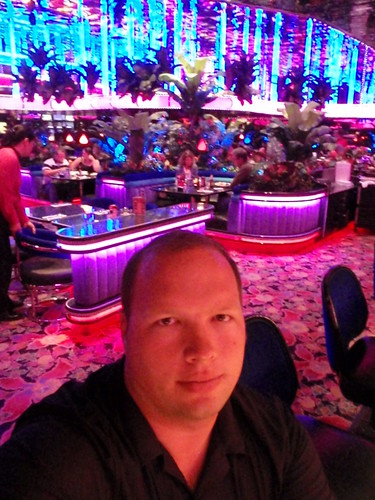
One thing about Wendover really struck me. Since I rolled into town on the Nevada side, and left town on the Utah side, I crossed the state line on the main road in town. It’s big and white, and painted across the middle of the street, with block letters labeling which side corresponds to each state. The casinos are built right up to state line, in such a way that the parking lots for casinos are in Utah.
If you look at the satellite photo, you can see the white line in the middle of the street (center of the frame), and the arrangement of the buildings and parking lots. The line really represented fun. Crossing that line was like driving into the place where no fun is allowed (Utah):
View Larger Map
It was bike week at the Bonneville salt flats, so there were tons of motorcycles in town. The salt flats are a few miles outside of Wendover, so everyone attending was staying in town. Which may have been why a number of the hotels were full. I was invited by some other bikers to ride out to the salt flats with them, but I wanted to get my day started earlier than they did. They were heading out at 9am, I hit the road just after 7am, after all, I’m trying to ride 600 mile each day, which seems to mean about 12 hours on the bike.
To facilitate getting so much business done each day, I de
veloped a strategy for stopping and getting going. In the evening, when I pull into the city I’m staying in, my first stop is at the gas station to fill the bike up. The last thing I want to do is have to deal with filling up on my way out of town. I pack all of my bags as much as possible laying out clothes for the next day. Showering, which I normally do in the morning moves to the evening because it’s nice to have a shower after 12 hours on the bike and because it’s one less thing to do in the morning before heading out. The day operates much like this:
- Wake Up
- Dress
- Snack (granola bar)
- Luggage onto bike
- Check out of hotel
- Leave
- Ride 100+ miles
- Eat a real breakfast + get gas (usually stop at 9:30 or so)
- Ride 100-200 miles at a time, stopping for gas
- Around 600 miles, find a hotel (usually 7:30pm)
- Get gas
- Check In to Hotel
- Soak in hot tub
- Shower
- Dinner
- Plan route for next day
- Relax for a bit
- Pack everything and set alarm
The Route:
View Larger Map
Day Two – 614 miles:
Motel 6 in Wendover, UT to Ramada Inn in Casper, WY.
First, Sunrise in Wendover:
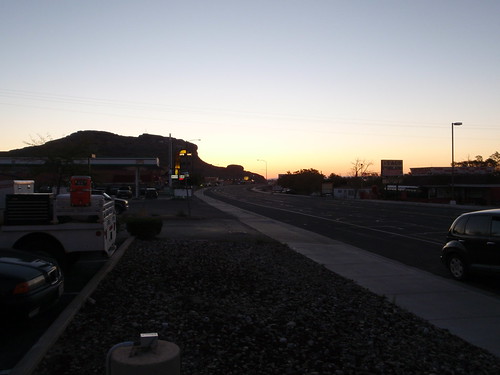
On day two, we learned a number of things:
- Utah and Wyoming have some awesome landscapes
- There is risk involved in trying to take roads that even the locals haven’t heard of
- Casper, Wyoming is at elevation of 5123 ft.
We also perfected the art of picking a hotel based on the roadside signs, but more on that later.
I made very quick work of Utah. It helps that I was cutting across the top of the state, which is much narrower than the Southern section. I stopped for breakfast on the far side of Salt Lake City and was certainly into Wyoming before lunch time. Since I wasn’t really eating a proper lunch, sometimes it’s hard to tell what time it is in the afternoon, but lunch should probably have been eaten in Green River, WY. In lieu of lunch, I struck up a conversation with a biker I’d run into on the highway. He pulled on as I passed and we rode unofficially together for 50 or so miles. It turned out that we both needed gas at the same stop. It turned out that he was on 2 weeks of leave from a tour of duty in Iraq and was spending it on his bike. He’s spent 2 days getting his Harley out of storage and fitted with some luggage and had been on the road for not quite a week. He was a nice guy and we talked motorcycle stuff for a while. He was excessively calm; the kind of calm that I sometimes see in my cousin who did a tour in Iraq disarming roadside bombs. We kept an eye on eachother’s bikes/gear while we were inside.
Inside the gas station convenience store, the clerk was from Ghana, which was not at all what I was expecting. Having not seen a person not of white or Latino ethnicity in many hundred miles, this was not what I was expecting in Green River, Wyoming. It’s amazing what a monoculture our country is when you get away from the coasts and urban centers.
On the map below, you can see a forty or so mile outcropping in Rawlins, Wyoming. On the map, the road looks like it would be really interesting: it cuts in between two lakes and has a lot of kinks which would make for interesting riding, not to mention break things up after 2 days of relatively flat and straight roads. I thought to ask the truckers and station attendants at my gas stop if the road was interesting or useful. For whatever reason, no one would admit to knowing anything about it. It turns out that the reason no one bothers with it is that it turns into a gravel road forty miles in. It might actually go all the way from Rawlins to Casper, but progress would be quite slow. I didn’t think learning to dual-sport in the middle of nowhere with a bike loaded down with luggage where no one would find me should I wreck was a good idea, so I made the executive decision to head back to the main highways. Regrettable, I lost two hours to the excursion, which put me well behind my stretch goal of ending up in South Dakota that night. Little did I know, it was about to get a bit worse.
Once back on the main highway, which was essentially a straight hundred miles across a valley, I discovered two things: altitude and wind. Rather aggressive cross-breezes made staying in a lane a bit trickier than usual. This highway was a two lane, no barrier, 75mph kind of affair, so when you get blown into the next lane, you’re either off the road, or in oncoming traffic. Neither of these scenarios is particularly interesting to me which made it a rather intense couple of hours. The altitude also began to kick in. I was dressed for 85 degrees. By the time I got into Casper, I was frozen and thinking myself a complete wuss for shivering in 65F weather. For kicks, I looked up the weather in Casper in the iphone and discovered that the official temperature was 43F.
Did I mention that it was really foggy and started raining a few miles outside of Casper. The combination of all of these factors lead me to elect to stay in Casper that night rather than press for South Dakota, where the town I really wanted to be in was still 150 miles away. The combination of the temp, rain, and sun setting didn’t give me good feelings about putting on more miles, and there really wasn’t anything between Casper, WY and Hot Springs, SD. This was sort of a bummer, because I had planned to burn a few hours having the muscle aches massaged away after a good soak in the hot spring, had I made it to South Dakota on that second evening.
This is where my hotel choosing fu came into play. I elected to stay at the Ramada I
nn because they advertised an indoor heated pool and hot tub. I was probably the only person that week that asked the specific questions: "You have a hot tub, right?" and "It’s currently working, right?" before handing over my credit card. Although it was far from full, there were enough people in the hotel bar/restaurant to give it a sense of ambience. I had some food and beer (all after the preliminary soak in the hot tub) and accidentally caught the premier episode of Trueblood on HBO.
View Larger Map
Day Three – 651 miles:
It rained overnight. It was far from certain that it was going to continue to not rain for the rest of the day. Normally, I would say something like "stay clear", but the skies were so foggy that clear would a rather poor description of the weather conditions. In fact, it was so foggy (humidity at 98-100%) that the water was collecting on my windscreen, beading up, and flying onto the visor of my helmet. Also, It was still 43 degrees Fahrenheit in the morning, which did not endear me to the possibility of rain. Fortunately, aside from a few light rains that lasted for a few minutes each, the weather held.
I feel compelled to point out that in the general case, I do not mind riding in the rain. I actually like it. In this case, the cold was the big deal for me rather than the wet. However, I hadn’t actually been able to test this jacket/pants in the rain before the ride, so I was unsure what the result would be. The only thing that would be worse than being too cold, would be being wet and too cold. Remember that the 70mph worth of wind chill is a real hoser sometimes. Being wet on top of it being 45F is unlikely to improve the situation. Don’t you worry: I did get to test the rain worthiness of my gear later in the trip.
My breakfast stop on day 3 was in Lusk, WY. At the diner that I ate at, the restrooms, rather than having the traditional signs reading "men" or "women" had had-carved pieces saying "cowgirl up" and "cowboy up". Also, they had a few racks of knicknacks that included one-size-fits-all gloves for kids, which also fit underneath motorcycle gloves, which was a real win. With my new found electric blue glove liners, my hands stopped getting cold, which was a nice contrast to my arrival in Lusk, wherein I was unable to take off my helmet for a few minutes because my fingers were too cold to feel and operate the strap. The additional glove liners have the nice side effect of making the diameter of the handles that much greater, which is more comfortable. I’m toying with the idea of designing and marketing motorcycle grips that are just a bit bigger to be easier on the hands.
The bike in front of the Outpost Cafe sign in Lusky, WY and the sign on the door to the Ladies’ Room that reads: "Cowgirl Up"


These photos prove beyond all shadows of doubt that I was in Wyoming. I know there are some that doubt it’s existence and this is for them. I was there. it’s nice.
Most important on the third day was my visit to the Badlands (more formally known as Badlands National Park). The genesis of the entire trip was my inclination to ride the motorcycle to the Badlands. It sort of makes you a Bad Ass, and who doesn’t want to be a bit of a Bad Ass. I don’t have any particularly good reasoning for my attraction to the Badlands, nor am I convinced that there is one. It seemed like something I should do and it seemed that way for a long time. I could spend pages gushing about how interesting the Badlands are as geographic features, but I’m going to post some of the pictures and let them tell the story.
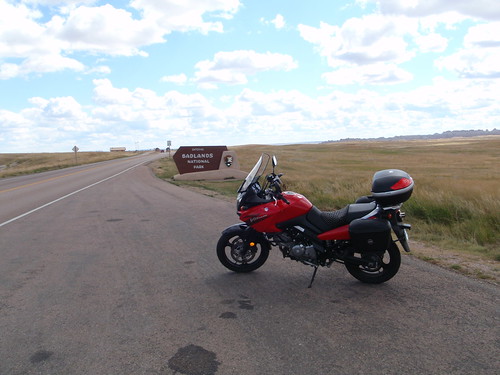

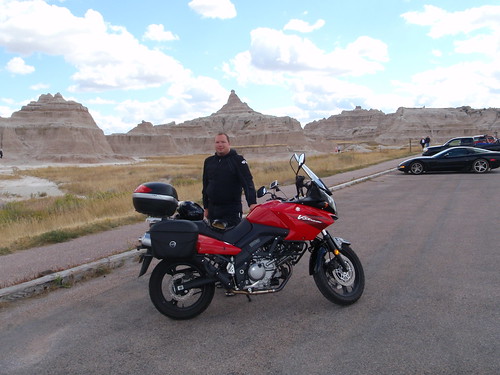

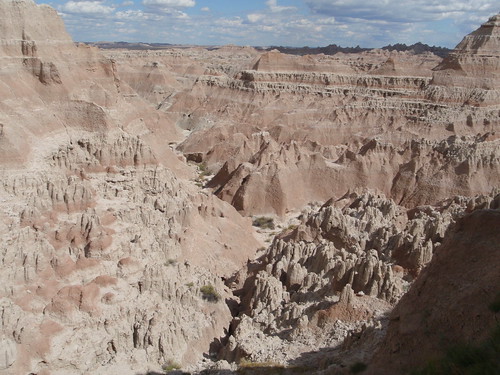
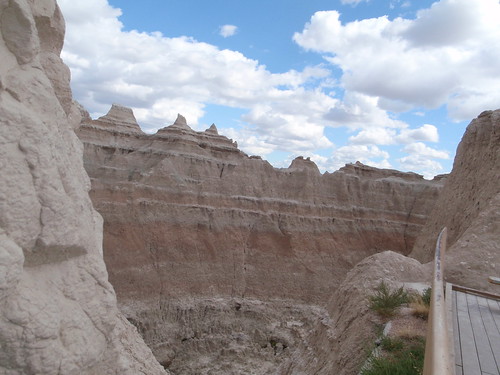

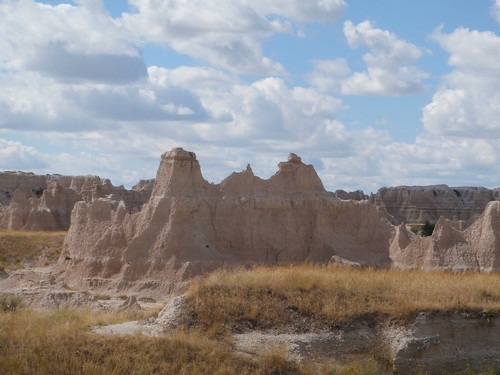
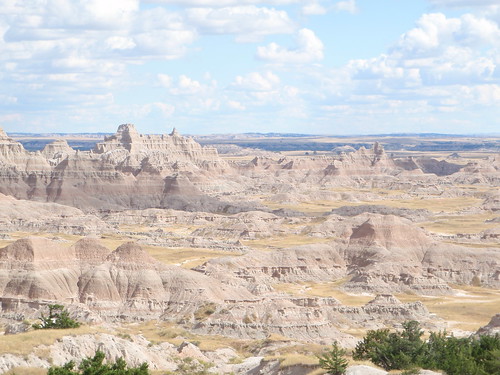
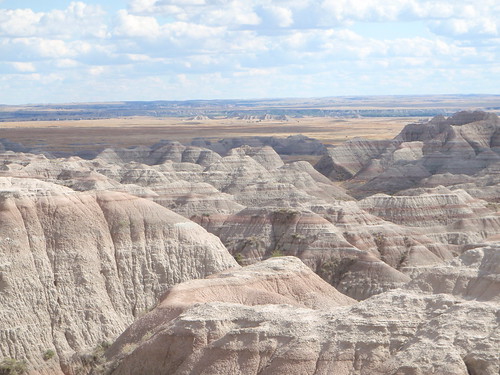
And lastly, My favorite: The only curved road in South Dakota 🙂

Looking at the map, I had figured my overnight stop would be in Mitchell, South Dakota. As luck would have it, just outside of Mitchell there is a billboard advertising a hotel in Sioux Falls, which is another 65 miles or so past Mitchell. Actually, there are lots of such billboards, but this one suggested that the Ramada Inn had a Tiki Bar and an indoor water park. I got gas in Mitchell and made sure that riding to Sioux Falls wasn’t out of the question. The women who were in charge of the gas station confirmed that Sioux Falls was only another hour away and that the Tiki Bar did sound like something worth checking out.
The combination of a Tiki Bar and water park in the Ramada Inn ended up being completely worthwhile. I even managed to catch the last few minutes of the Packer game on the television in the bar, which was Aaron Rodgers first game at the helm (not counting pre-season). The bartender was from Wisconsin and a packer fan. He’d taped over his Brett Favre jersey with Aaron Rodgers name and number with electrical tape. Packer fans are great!
After dinner and a couple drinks at the tiki bar, it was time to hit the water park. Interesting fact about the water park: it closes for kids at 10pm, but for adults, it’s open until 11pm. They failed to mention they turn the slide off at 10pm as well. Fortunately, I got there just in time to ride it and what a ride it was! It seemed like it took forever to get down the thing, even in my floppy noodle state at the time. The water park does get marks off for having a very shallow landing pool that I scraped my foot on. What’s an adventure without injury though?
The icing on the cake at the Ramada Inn was that each room came with a bottle opener, just in case. At first I thought it was a gift from the previous occupant, but it was tied down to the room. I fully endorse the Ramada Inn in Sioux Falls.


View Larger Map
Day Four – 517 miles:
Sioux Falls, South Dakota (not to be confused with Sioux City, Iowa) is on the border of those two states. I discovered that I could take surface roads to a highway that would dip me into Iowa and only increase my route by a few miles. This seemed worth it, since I’ve no particular interest in Iowa, but don’t mind checking states off the list of places I’ve visited. Of course, I got a bit lost in Iowa which resulted in a 2 mile detour, but I still feel it was worth it.
After I’d made my way through the northwest corner of Iowa, I was in Minnesota. Minnesota is known as the "land of lakes" although my experience suggests that "the skunk roadkill state" would be a more apt name. Sure I saw a few lakes on my way through (although I’ve been told that Wisconsin actually has more lakes per square mile and per capita than Minnesota) but I saw a flat skunk on the side of the freeway every 10 miles or so. That’s a lot of skunks. In fact, I didn’t believe the first few that I saw, until I ended up behind a slow trunk and got to take a good look (and smell) of one.
Minnesota is also a place where the geology starts to change. By the time you’re in Wisconsin, you’re essentially in a forest. If you’re in South Dakota, it’s mostly flat. Minnesota is the middle ground. Unfortunately, just as most compromises, it’s not desolate, nor a forest, nor particularly interesting as landscapes go. You do start getting some subtle elevation changes in the roads though, which is nice. (Readers in California would not even notice the elevation changes.)
Speaking of elevation changes, I saw a sign for a ski hill in Minnesota. My only response was: "where". As far as I can discern, there wasn’t a significant hill for miles. Perhaps I’ve been spoiled by having my only snowsport experience being in the Lake Tahoe area.
Into Wisconsin, I rode through the Wisconsin Dells. I’m not actually sure what the Dells are, but I think they’re a region particularly well populated with lakes that has been turned into an entertainment area. I think it’s a very midwestern version of Lake Tahoe (also how I describe the notion of going "up north", which you’ll understand perfectly if you’re from Wisconsin and makes no sense otherwise). My ride through Wisconsin is mostly unremarkable because I’ve already spent a lot of time there visiting family. The corn was thigh high.
I rolled into my Aunt’s place where I was to stay around 5:00pm, which was a little later than I had wanted, but still good time. It was getting harder and harder to wake up before 7am every morning because I was losing time every time I’d cross a time zone. When I did pull into the driveway, I found that the garage had been left open, as one does when one is expecting company in Wisconsin and that there was plenty of space available to park a motorcycle
. I parked and started taking off my riding gear getting ready to settle in.
This is where it all caught up with me. If you’ve done some motorcycle touring, maybe you can let me know if this is something you experienced as well. Perhaps it was worse because I was traveling alone? For the next four or five hours, I was in a state of near shell shock (I was literally trembling). Mostly in a daze, I was in no position to answer questions of have opinions on any topic, including the obviously useful ones like "what do you want for dinner" or "who are you planning on visiting while you’re here". It was as though all of the intensity of riding 12 hours per day for the last four had finally caught up. In a way, even though I’d been at hotel bars and restaurants (and water slides), but I hadn’t had to really deal with people in a meaningful way. Melanie and Iris got a taste of this when I arrived in NYC and was mostly useless for about two hours; perhaps there’s an hour of recovery for each day spent on the road.
It was also on day four that I discovered that some my equipment had begun to fail. I realize that Joe Rocket is not known for their high quality, or at least wasn’t when I last looked into their stuff five years ago. It seems that they haven’t come very far from there. The good news is that the stuff was sufficiently inexpensive that I’m still well ahead of where I expected to be even after having one zipper replaced and one seem re-stitched. The lacking quality hasn’t actually dampened my enthusiasm for the jacket I have, which describes itself as being convertible for use in all four seasons. In winter mode, it’s certainly capable of keeping the water out and the wind off, and in summer mode, it breathes really well without exposing too much mesh to the world. The pants don’t breath as well as I’d like them too, but are certainly water proof. The jacket had a seem where the stitching was simply coming undone, which I noticed because I had a cold spot the size of a quarter on my side. The zipper to the pants just failed as I was taking them off after arriving at my aunt’s place. I found a sewing & alterations place in the next town that repaired everything for $21, same day. I fully endorse The Sewing Basket in Mukwonago, Wisconsin.
View Larger Map
Day Five – 623 miles
Waterford, WI to Du Bois, PA
Day five ended up being a five-state Day, which is saying something considering that 30 of the miles ridden that day took ~4.5 hours. The plan was to head south out of Racine, WI into Chicago and then pick up 80 going east. This was a fine plan until I discovered that 80 was flooded in Indiana and had thus been closed in Chicago. A fair characterization would be: no one had a clue what to do. Especially not the attendant at the gas station I stopped at on the south side of Chicago, which was probably the shadiest place I stopped on the entire trip, although I can’t really say it’s any worse than the gas stations nearest my house. The culture is a little different, so it felt trickier to read people. I’m sure it felt a lot sketchier than it actually was, after all, many of the patrons were filling up their cars with gas.
Being routed away from the obvious route, I had to so some re-arranging to make a go of it, so I bought a map. The only useful map at this gas station was the map of the entire US. This proved useful enough when combined with the map feature on my iphone and the maps on the GPS. (I could write an entire blog post about what I’d like the GPS to be able to do for me after this.) I chose the "next best route" which was to take highway 57 down to highway 30 into Merrillville, IN where I could figure out what to do with myself. On paper this was a good idea. In actuality, it was the only idea, so everyone that would normally have been on 4 lane freeways ended up on the same 2 lane road that I was on. 5 hours to go 30 miles.
It wasn’t all bad though. Once I finally got to Merillville, IN, I needed to regroup. I figured I’d hit the ‘net and check out the highway closures on the INDOT site to decide if I could head north on the main highway (65) of if I needed to backroad it further to avoid the flood. I pulled into a parking lot at a Bob Evans because it was next to a La Quinta, which I thought was likely to have free wi-fi (it did). I whipped out the laptop and started looking for road closure info and found out that things looked like I thought they should. I confirmed what I read by taking a look at the highway and seeing traffic flowing at a reasonable rate (and no long lines of big rigs) which indicated that things were working acceptably on the main route. I will eventually find out how wrong that conclusion was, but first there’s business to take care of.
On my way into the parking lot, I spotted a three bikes. This itself isn’t that big of a deal, but these weren’t Harleys which is a bit rare in that part of the country. Even more rare, was that two of these were Italian bikes which you just don’t see in the midwest as far as I’m aware. There was a Ducati 1098 in race trim on a trailer, and a Moto Guzzi Nevada Classic (a cruiser). The third bike was a Kawasaki sportbike. All of the owners were on their way out of the restaurant and were getting ready to head out, so I got to chat with them. We compared notes on the crummy traffic and what routes we thought we were going to take. It turns out they were on their way home to Buffalo, NY from the MotoGP which was at the Indianapolis Motor Speedway.
It turns out that their plan of staying on 30 until the next highway before cutting north back to 80 was the right choice. I ended up in more traffic getting back to 80 as a result of the following tactical blunders:
- 80 was open according to INDOT.
- 80 was in fact open in Indiana.
- 80 was closed in Illinois.
- My location was 10 or so miles across the IL/IN border.
All traffic was being diverted onto 80 East, since 80 West was closed a mile down the road, which narrowed four lanes into a single one. But wait, there’s more! To get on to 80 East you had to use an on-ramp that had a foot of standing water on it at it’s deepest. The length of the flooded section of the ramp was roughly 150 feet long. Fortunately, I’ve been reading a fri
end’s blog, which comprises the entirety of my knowledge of dual sport riding as well as fording streams. Keep the revs high, slip the clutch, and DON"T STOP. It sounded easy enough. I worked to leave a good gap between me and the car in front of me, since the last thing I wanted was for them to slow down and have to stop in the middle of the water. At that point it was a textbook maneuver. I followed the line that I’d selected as being shallow and unlikely to have hidden potholes based on the rest of the ramp. The revs stayed up even as water was washing over my toes. The best part was that I got a standing ovation from some highway workers who were watching the whole thing happen. I reciprocated with a fist pump as I sped away onto the open road for the first time in five hours.
Once on 80 proper, my goal was to get to Pennsylvania. I made pretty quick work of Indiana (it’s not that big) and then Ohio. Ohio was longer and threw some rain into the mix but I was unphased. Fortunately, my gear kept the water off and it was hardly a bother. I did end up discovering some interesting moves I could make with my neck to use the airflow to push the water off of my visor. The jacket and pants kept me completely dry and warm so no complaints there. I ended up running into my friends with the Ducati and Motoguzzi once again at a gas stop. I had passed them once in Indiana giving them the international symbol for "hang loose" on the way by, which probably looked like an obscene gesture with a glove on though they later said the recognized the bike and all was well. Apparently they leapfrogged me at my previous gas stop before I caught them at this one. We had a good laugh about that and compared our routes of Merrillville. I thought they’d made the right choice, but they’d hit some traffic too. Since I passed them it couldn’t have been so different, although now that I’m thinking about it, they probably left 15 minutes ahead of me at least. Perhaps I’m the winner of that round after all.
I’d decided that I would stop in the first town I got to in PA, since I didn’t have far to go to NYC once I was there. I did make the mistake of thinking that Pennsylvania was a populous state, my only previous experience having been in Philadelphia which is quite urban. I remember pulling off the freeway into a town, where town is defined as some place that has a sign suggesting humans and gas stations only to find that it was 10:02pm, and the gas station was completely dark. A little bit scary given the dwindling reserve of gasoline in the tank and the prospect of more closed gas stations. Fortunately, 16 miles later there was a 24 hour place that was more truck stop oriented so I was able to fill up. For whatever reason, I didn’t like place, so I decided to ride on until I found something that suited me, which brought me to the Holiday Inn Express in Dubois, PA. There were two hotels in Dubois, but the Holiday Inn Express looked like the nicer place. It certainly had more cars in the lot (it was nearly midnight) and looked generally well cared for. It also was up on a hill, which made me think the riffraff would tend to look elsewhere to cause their trouble. Evidently, I’m not the only motorcyclist who thought this, as I found five other bikes in the parking lot, including another V-Strom. When I checked in the clerk volunteered that I could park anywhere I like, other than the sidewalk, which was verboten. Apparently, this is an issue, and as I parked I discovered a number of sidewalks that didn’t really go anywhere that we otherwise prime parking spots. Who knew?
I hesitate to include that at one point on a completely stopped freeway I did something of questionable legality to get to an exit, though I don’t think it was dangerous at the time, as all traffic was stopped, and I don’t mean stopped traffic like we usually think of in CA, I mean stopped like that time we were on our way to Emily and Nicklaus’ wedding that we had a ten minute break on the bay bridge where people literally got out of their cars and danced in the street because there wasn’t anything else to be done at that point. I’m including this bit mostly as a reminder to myself should I forget. I haven’t included specifics, so unless you saw me you’ll never know, and therefore can’t write me a citation after the fact. If you catch me in person, ask me about it though, it’s a good story.
Overall, it was a sixteen hour, five state day, even if it only covered 623 miles. For reference, the states were: Wisconsin, Illinois, Indiana, Ohio, Pennsylvania.
View Larger Map
Day Six – 292 miles
The sixth and final day of riding was mostly uneventful, especially in the morning. I got up around 6:00am to be out of the hotel by 7:00am. I opted out of my normal strategy of riding 100 miles before breakfast in favor of the waffles and eggs on offer from the continental breakfast mostly because I’m a sucker for a freebie and it looked good enough. I had less than 300 miles to go, so it wasn’t going to be a normal day anyway, and I didn’t feel that I needed to push as hard.
I made pretty quick work of the rest of Pennsylvania, which was mostly unremarkable and made it into New Jersey, which is a very small state. It does have the Poconos, which I’ve never spent any time in, but sound like the punchline to a joke that starts in Long Island or something. It’s fun to say and might even be fun to visit. Maybe next time?
Before I knew it, I was in the city of Newark, which is where the roads turn awful. What is it about urban areas that requires the quality of the roads go to pot? Potentially fortunate was the dual-sport aspirations of the V-Strom, because there were pot holes and imperfections a plenty. I’m at a loss to understand how people ride sport bikes in environments like this… or drive cars; it’s that bad.
In New Jersey, you do begin to notice that traffic becomes more and more dense as you approach New York City. The approach to NYC by road involves a maze of complicated overpasses, underpasses, and tunnels, all of which are good fun, and all of which you’re technically not supposed to change lanes in. You can probably guess how well followed that rule is.
Once in Manhattan, everything changes. As put by a friend, driving in Manhattan is like driving in a vid
eo game. When first arrived in Manhattan I was mindful of the rules of the road, a notion that I was quickly disabused of after three blocks. Having gotten my head straight about how the game is played, it because a lot more fun and I ended up making pretty good time through the city, taking full advantage of the relatively small size of my motorcycle.
My route took my across the Manhattan bridge into Brooklyn, where I figured I would try and find the base of the Brooklyn Bridge for a photo. Unfortunately, I did a very good job of finding the Brooklyn Bridge and was on my way over it back into Manhattan before I knew it. I navigated Manhattan in a particularly non-efficient route back to the base of the bridge and managed to get my photo, only going ten minutes out of my way. Once I was done with that, I was on my way back over the Brooklyn Bridge to King Cycles, where I was going to drop my bike off so that it could be shipped back to CA.
All in all, I made it to my destination in Brooklyn by 2:00pm after dropping off the bike. Not bad time wise, although I was rather ravenously hungry by my arrival, which was easily fixed with a bagel.
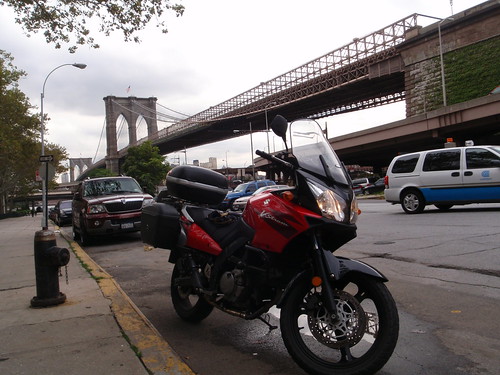
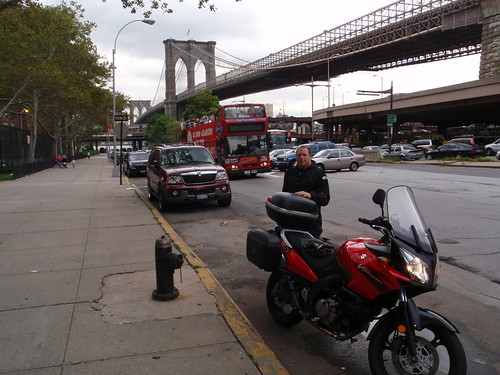
View Larger Map
Overall, I would recommend this kind of trip to anyone who has the ability to do it. It is certainly a test of endurance and concentration, which is the sort of thing that I really enjoy. If I were to do it again, i would allow myself more time and few miles each day so that I can indulge my curiosity along the way. For example, I did not get to check out the corn palace in South Dakota, not the automotive museum featureing the "real" Dukes of Hazard car (there were 12 or 13).
About the bike:
The bike is a 2006 Suzuki DL-650 V-Strom. My experience confirms the research that that this bike is great in just about every way except the harshness of the wind coming off the windscreen. Mine was fitted with a Givi aftermarket windscreen by the previous owner which supposedly makes it better. I haven’t put the stock windscreen on to see what it’s like, but presumably it’s worse. The bike is also fitted with Givi hard bags and a top case. The bags remove pretty easily and I have very few complaints about them. The top case is a godsend for day-to-day use, and I’ll probably be fitting all of my future motorcycles with one. This one is big enough to hold my messenger back handily while I’m riding, or my helmet, gloves, and jacket while I’m parked.
If I were to do another trip like this, I would probably choose a different bike. It seems that the rest of the country rides Harleys, which I have some fascination with. Given the terrain of North America and the roads that we have, I’m prone to thinking that a four-cylinder engine is more appropriate. Something along the lines of an FJR-1300, Councours, ST1300 or BMW K series would be the ticket for the long hauls on the interstates. I also find myself wishing for a greater fuel range. While 240 miles on the V-Strom is a long range as far as motorcycles go, i would have benefited from having 60 more. I think 300 is the magic number.





















